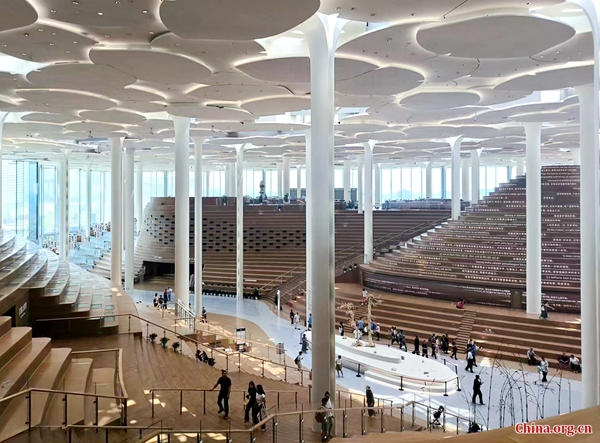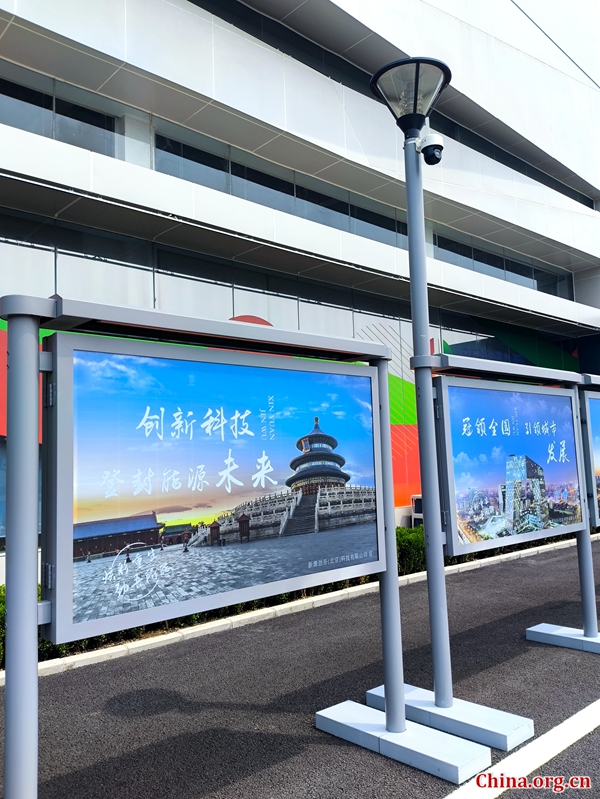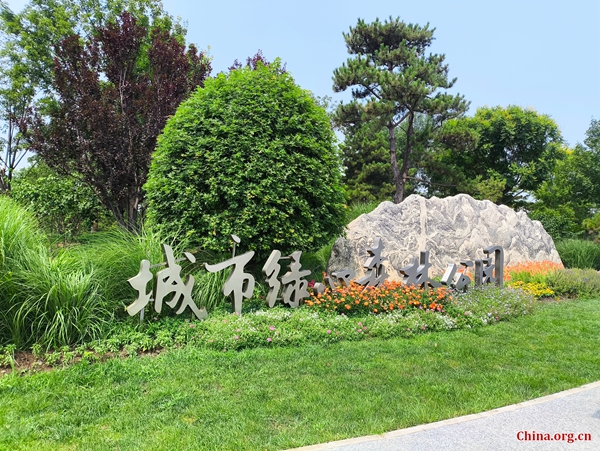
 0 Comment(s)
0 Comment(s) Print
Print E-mail China.org.cn, July 12, 2024
E-mail China.org.cn, July 12, 2024In December last year, Beijing's Municipal Administrative Center, located in Tongzhou district, unveiled three major cultural landmarks: the Beijing Performing Arts Center, the Beijing Library and the Grand Canal Museum of Beijing. These attractions have since attracted substantial numbers of visitors.

The Beijing Library, July 11, 2024. [Photo by Xu Xiaoxuan/China.org.cn]
Covering a collective area of 550,000 square meters, the venues and their shared spaces utilize a ground-source heat pump system for heating and cooling. This system reduces carbon dioxide emissions by 10,000 metric tons annually and cuts energy consumption by 3,800 metric tons of standard coal equivalent, achieving an energy-saving rate of approximately 45%, according to Pan Jiachen, deputy director of the Green Energy Department of an ecological environment subsidiary under Beijing Investment Group.
In February, Beijing's sub-center gained further momentum in green development with the State Council's approval of a plan for building a national green development demonstration zone. The plan aims to integrate green development concepts into all aspects of the sub-center's economic and social development, positioning it as a pilot hub for innovative green technology application.
An exemplary case of green technology development is ColorFuLead Power (Beijing) Technology Co. Ltd. based in Tongzhou. Established in 2022, the company focuses on innovative applications of full-color optoelectronic functional materials and comprehensive recycling of photovoltaic modules.
China, which is home to nearly half of the world's installed photovoltaic capacity, faces challenges in effectively recycling and managing decommissioned photovoltaic equipment, which can lead to declining efficiency, high water consumption and severe pollution.
Liu Yuan, director of the Supply Chain Management Department at ColorFuLead, highlighted the company's development of its advanced colorful microlayer technology (CMT). He noted that this technology can upgrade various photovoltaic modules by integrating colors and patterns into their appearance, harmonizing them with external environments while maintaining their ability to convert sunlight into electrical energy. As of the end of June, ColorFuLead had filed 209 patent applications.

Advertising boards made from full-color optoelectronic functional materials, July 11, 2024. [Photo by Xu Xiaoxuan/China.org.cn]
Zhang Shilei, director of the Marketing Department at ColorFuLead, explained the wide application of full-color optoelectronic functional materials in architecture, commerce, advertising, municipal projects and emergency scenarios. "A single retired 260-watt photovoltaic module repurposed into a full-color photovoltaic sign can provide 200 kWh of green electricity annually, reducing carbon emissions by 166 kilograms and saving 61 kilograms of standard coal equivalent, equivalent to planting nine trees," Zhang explained.
ColorFuLead has also developed energy cabins utilizing full-color optoelectronic functional materials. A 38-square-meter energy cabin can generate 20 kWh of photovoltaic electricity daily with a storage system capable of sustaining operations for seven consecutive rainy days. It serves dual purposes: as a resting station or kiosk in normal times and as a command center or temporary medical station during emergencies.
Zhang also noted that full-color optoelectronic materials contribute to the new quality productive forces and affirmed the company's commitment to collaborating with the Tongzhou government to further enhance the district's green power supply.

Central Green Forest Park, July 11, 2024. [Photo by Xu Xiaoxuan/China.org.cn]
The implementation plan for building a national green development demonstration zone at the sub-center also aims to make Tongzhou a model for harmonious coexistence between humanity and nature. Central Green Forest Park, a green gem embedded within the sub-center, serves as a natural oxygen bar for residents.
With a planned area of 11.2 square kilometers and a forest coverage rate of over 85%, the park has welcomed over 10 million visitors since opening in 2020. Additionally, the park aims to restore ecological functions and protect biodiversity by setting up an ecological buffer zone and an animal migration corridor.
Notably, the park's supporting architecture all utilizes ground-source heat pumps for heating and cooling. The rooftop photovoltaic power equipment also contributes green power to the buildings, further reinforcing the park's commitment to sustainability.
Go to Forum >>0 Comment(s)